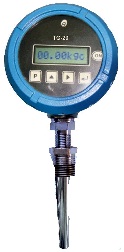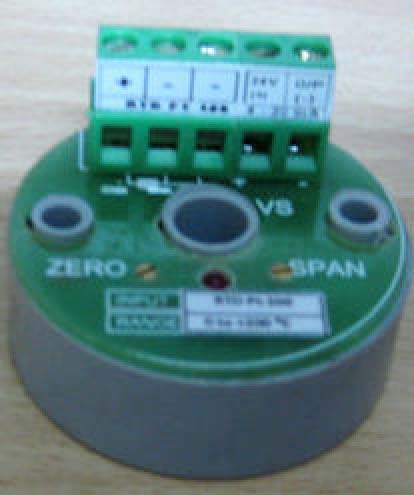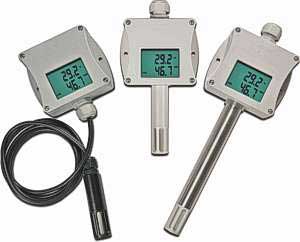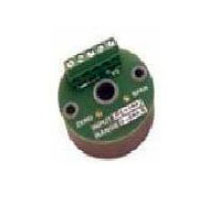Temperature Transmitter
Leading Manufacturers, Exporters, Wholesaler of Temperature Gauges and Temperature Transmitters from Ahmedabad.
| Business Type | Manufacturer, Exporter, Supplier |
| Material | Mild Steel |
| Shape | Round |
| Color | Blue |
| Application | Used To Measure The Temprature Of Liquids |
| Feature | Accuracy, Easy To Fit, Measure Fast Reading |
| Display Type | Digital |
| Type | Temperature Gauges |
| Country of Origin | India |
| Packaging Details | BOX |
Temperature gauges provide a local visual display of temperature readings, often used in various industrial and commercial settings. Here's a breakdown of their typical specifications:
General Specifications
· Temperature Range: The range of temperatures the gauge can display (e.g., -40°C to +300°C).
· Temperature Dial: This displays the temperature scale (e.g., Celsius or Fahrenheit) and markings for the measurable temperature range.
· Pointer: This indicates the measured temperature on the temperature dial.
Performance Specifications
· Accuracy: Expressed as a percentage of full scale (%FS) or in temperature units (°C or °F). Typical accuracy for good quality gauges is ±2%FS to ±5%FS. Dial thermometers generally have lower accuracy than digital thermometers.
· Response Time: The time it takes for the gauge to reflect a change in temperature (usually slower than electronic thermometers, ranging from seconds to minutes).
Additional Features
· Stem Length: The length of the metal part inserted into the medium to measure temperature. Choose a stem length that reaches the point of desired temperature measurement within the process or environment.
· Material of Construction: The materials used in the gauge housing, stem, and dial. Common materials include stainless steel, brass, and plastic. The selection depends on factors like temperature range, pressure resistance, and corrosion potential of the environment.
· Fill Material (Liquid Filled Gauges): Some gauges are filled with a liquid (often glycerin or silicone oil) to dampen vibrations and improve pointer movement readability.
· Max/Min Recording (Optional): A feature in some gauges that tracks and displays the highest and lowest temperatures recorded.
· Alarm (Optional): Certain models can be equipped with alarms to trigger at pre-set high or low-temperature thresholds.
Environmental Specifications
· Ambient Temperature Range: The range of surrounding temperatures the gauge can function within without compromising performance.
· Ingress Protection (IP rating) (Optional): A rating for some gauges indicating their resistance against dust and water ingress (e.g., IP54 for dust resistance and splash water protection).
Factors to Consider When Selecting a Temperature Gauge
· Temperature Range: Choose a gauge with a range that covers the entire temperature spectrum you intend to monitor.
· Accuracy: Select a gauge with accuracy suitable for your application's requirements. Dial thermometers may be sufficient for non-critical applications where high precision isn't essential.
· Response Time: Consider how quickly you need the gauge to reflect temperature changes in your application.
· Stem Length: Choose a stem length that reaches the appropriate measurement point within your process or environment.
· Material of Construction: Select materials compatible with the temperature range, pressure, and potential corrosive elements in your application.
· Additional Features: Consider optional features like max/min recording, alarms, or an IP rating based on your needs.
By understanding these specifications and factors, you can select a temperature gauge that provides a clear and reliable visual indication of temperature for your monitoring applications.
| Business Type | Manufacturer, Exporter, Supplier |
| Color | Green |
| Condition | New |
| Automatic Grade | Automatic |
| Power Source | Electric |
| Application | Industrial Automation |
| Style | Head Mounted |
| Certification | CE Certified |
| Type | Temperature Transmitters |
| Country of Origin | India |
| Product Code | Temperature Transmit |
| Payment Terms | T/T |
| Packaging Details | Any |
Temperature transmitters are workhorses in industrial process control and automation. They convert the signal from temperature sensors (like Resistance Temperature Detectors (RTDs) or thermocouples) into a standard electrical signal, typically a 4-20mA current loop. This allows for accurate and reliable transmission of temperature readings over long distances. Here's a breakdown of their typical specifications:
General Specifications
· Temperature Range: This specifies the range of temperatures the transmitter can accurately measure. It can vary widely depending on the sensor type and application (e.g., -200°C to +1500°C for some industrial applications).
· Sensor Input: The type of temperature sensor the transmitter is compatible with (e.g., RTD Pt100, thermocouple K, etc.).
· Output Signal: The standardized electrical signal the transmitter sends, most commonly a 4-20mA current loop. Other options include 0-5V or 0-10V voltage outputs.
Performance Specifications
· Accuracy: Expressed as a percentage of full scale (%FS) or in temperature units (°C or °F). Typical accuracy for good quality transmitters is ±0.1%FS to ±1%FS.
· Resolution: The smallest temperature change the transmitter can detect and convert into an output signal. Higher resolution translates to more precise measurements.
· Response Time: The time it takes for the transmitter output to respond to a change in temperature (usually in seconds or milliseconds).
Environmental Specifications
· Ingress Protection (IP rating): A rating that specifies the level of protection against dust and water ingress. For example, an IP67 rated transmitter is dust tight and can withstand immersion in water up to 1 meter deep.
· Operating Temperature Range: The range of ambient temperatures the transmitter can function within without compromising performance. This may differ from the temperature measurement range.
· Material of Construction: The materials used in the transmitter housing and wetted parts (those that come into contact with the process environment). Common materials include stainless steel, aluminum, and high-temperature plastics.
Additional Features
· Communication Protocol (Optional): Some transmitters include communication protocols like HART or Modbus for remote configuration, diagnostics, and calibration.
· Display (Optional): Some models may have a built-in display for local temperature reading.
· Calibration: Transmitters need periodic calibration to ensure accuracy. Some models offer features like zero and span adjustments for easier calibration.
Factors to Consider When Selecting a Temperature Transmitter
· Temperature Range: Choose a transmitter with a range that comfortably covers the temperatures you intend to measure.
· Sensor Input: Ensure compatibility between the transmitter and your chosen temperature sensor type.
· Accuracy: Select a transmitter with accuracy that meets your application's requirements.
· Output Signal: Choose a standard output signal compatible with your data acquisition system.
· Environmental Considerations: Consider the ambient temperature range, dust/moisture levels, and required enclosure rating for your application environment.
· Additional Features: Consider optional features like communication protocols or a display based on your needs.
By understanding these specifications and factors, you can select a temperature transmitter that effectively converts temperature sensor signals into a reliable and standardized output for accurate temperature measurement and control in your application.





